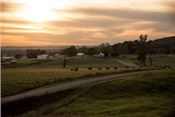|
2018 Forage Tour Aims To Give Producers An Edge In Livestock Production

Sunset over the Livestock and Forestry Research Station near Batesville. A tour here Nov. 2 will help
livestock producers learn how to get the most return on their forage investments.
U of A System Division of Agriculture photo by Fred Miller
BATESVILLE, ARK.
Ranchers and livestock producers will have the opportunity to learn which forages will give them the most bang for their buck in the fall at the 2018 Arkansas Forage and Grassland Council Conference and Tour, scheduled for Nov. 2.
Tour participants will have the chance to visit more than nine acres of no-till planted demonstration plots at the University of Arkansas System Division of Agriculture’s Livestock and Forestry Research Station near Batesville.
Attendees will see how to prepare a field, the best methods for planting and different options for fall forages.
“Some of the plots have already grown over 3 feet tall as of early October, and are likely not finished,” John Jennings, Professor of Forage for the Division of Agriculture, said. “That’s an amazing amount of forage to use for the fall grazing season.”
Researchers from the Division of Agriculture’s Animal Science Department will share results of a study on farm-finished beef, in which steers in a forage-based system were found to finish cheaper; the study also found that the number of animals in the study that were graded “choice” compared favorably with feedlot rates.
“Cover crops grown on row crop fields offer soil erosion control, but using them as a grazing crop gives during that time gives another income source,” Jennings said. “We’ll be sharing the experiences local producers on grazing cover crop mixes, animal gains and their suggestions for improving on this practice.
The conference will also address the emergence of the many toxic pasture weeds, due largely to the erratic weather patterns.
“Calls have been rolling in to county offices, with growers needing to know which weeds are toxic, are they toxic in hay, and other questions,” Jennings said. “At the conference, producers can test their skills at identifying toxic versus nontoxic pasture plants.”
Commercial exhibits and booths will be set up for attendees to see the latest forage management products, and other new forage results will be discussed and how producers can use the information to improve their forage systems.
Conference details:
Registration begins at 8:30 a.m.; the conference at 9:00 a.m.
Registration may be paid at the door by cash, credit or debit card, or check.
The conference fee is $45 per person, $60 per couple, and $10 for students.
Pre-registration is encouraged to help with conference and lunch planning.
Anyone wanting to improve their forage system should attend this conference and tour.
For more information about the conference or to pre-register, call Linda McCargo at 501-671-2171. The Batesville Livestock and Forestry Research Station is located at 70 Experiment Station Dr, Batesville, AR 72501; phone 870-793-7432. ∆
|
|